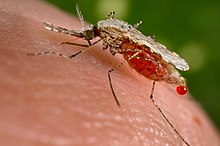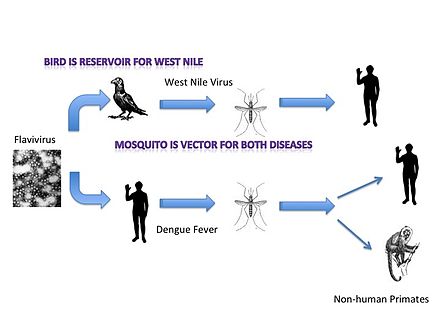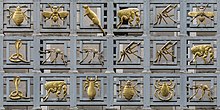Vector (biology)

In epidemiology, a disease vector is any living[1] agent that carries and transmits an infectious pathogen such as a parasite or microbe, to another living organism.[2][3] Agents regarded as vectors are mostly blood-sucking insects such as mosquitoes. The first major discovery of a disease vector came from Ronald Ross in 1897, who discovered the malaria pathogen when he dissected the stomach tissue of a mosquito.[4][5][dead link]
Arthropods

Arthropods form a major group of pathogen vectors with mosquitoes, flies, sand flies, lice, fleas, ticks, and mites transmitting a huge number of pathogens. Many such vectors are haematophagous, which feed on blood at some or all stages of their lives. When the insects feed on blood, the pathogen enters the blood stream of the host. This can happen in different ways.[6][7]
The Anopheles mosquito, a vector for malaria, filariasis, and various arthropod-borne-viruses (arboviruses), inserts its delicate mouthpart under the skin and feeds on its host's blood. The parasites the mosquito carries are usually located in its salivary glands (used by mosquitoes to anaesthetise the host). Therefore, the parasites are transmitted directly into the host's blood stream. Pool feeders such as the sand fly and black fly, vectors for pathogens causing leishmaniasis and onchocerciasis respectively, will chew a well in the host's skin, forming a small pool of blood from which they feed. Leishmania parasites then infect the host through the saliva of the sand fly. Onchocerca force their own way out of the insect's head into the pool of blood.[8][9]
Triatomine bugs are responsible for the transmission of a trypanosome, Trypanosoma cruzi, which causes Chagas disease. The Triatomine bugs defecate during feeding and the excrement contains the parasites, which are accidentally smeared into the open wound by the host responding to pain and irritation from the bite.[10][11][12][13]
There are several species of Thrips that act as vectors for over 20 viruses, especially Tospoviruses, and cause all sorts of plant diseases.[14][15]
Plants and fungi
Some plants and fungi act as vectors for various pathogens. For example, the big-vein disease of lettuce was long thought to be caused by a member of the fungal division Chytridiomycota, namely Olpidium brassicae. Eventually, however, the disease was shown to be viral. Later it transpired that the virus was transmitted by the zoospores of the fungus and also survived in the resting spores. Since then, many other fungi in Chytridiomycota have been shown to vector plant viruses.[16]
Many plant pests that seriously damage important crops depend on other plants, often weeds, to harbour or vector them; the distinction is not always clear. In the case of Puccinia graminis for example, Berberis and related genera act as alternate hosts in a cycle of infection of grain.[17]
More directly, when they twine from one plant to another, parasitic plants such as Cuscuta and Cassytha have been shown to convey phytoplasmal and viral diseases between plants.[18] [16]
Mammals
Rabies is transmitted through exposure to the saliva or brain tissue of an infected animal. Any warm-blooded animal can carry rabies, but the most common vectors are dogs, skunks, raccoons, and bats.[19]
Vector-borne zoonotic disease and human activity

Several articles, recent to early 2014, warn that human activities are spreading vector-borne zoonotic diseases.[a] Several articles were published in the medical journal The Lancet, and discuss how rapid changes in land use, trade globalization, climate change and "social upheaval" are causing a resurgence in zoonotic disease across the world.[20]
Examples of vector-borne zoonotic diseases include:[21]
Many factors affect the incidence of vector-borne diseases. These factors include animals hosting the disease, vectors, and people.[21]
Humans can also be vectors for some diseases, such as Tobacco mosaic virus, physically transmitting the virus with their hands from plant to plant.[citation needed]
Control and prevention

The World Health Organization (WHO) states that control and prevention of vector-borne diseases are emphasizing "Integrated Vector Management (IVM)",[22] which is an approach that looks at the links between health and environment, optimizing benefits to both.[b][23]
In April 2014, WHO launched a campaign called "Small bite, big threat" to educate people about vector-borne illnesses. WHO issued reports indicating that vector-borne illnesses affect poor people, especially people living in areas that do not have adequate levels of sanitation, drinking water and housing.[24] It is estimated that over 80% of the world's population resides in areas under threat of at least one vector borne disease.[25][26]
See also
- Airborne disease
- Asymptomatic carrier
- Fomite
- Globalization and disease
- Insect vectors of human pathogens
- Insect vectors of plant pathogens
- VectorBase: genomic database of invertebrate vectors of human pathogens
- List of diseases caused by insects
- Natural reservoir
- Waterborne disease
- 2007 Yap Islands Zika virus outbreak
Notes
- ^ "Vector-borne zoonotic diseases are those that naturally infect wildlife and are then transmitted to humans through carriers, or vectors, such as mosquitoes or ticks."[20]
- ^ "IVM strategies are designed to achieve the greatest disease control benefit in the most cost-effective manner, while minimizing negative impacts on ecosystems (e.g. depletion of biodiversity) and adverse side-effects on public health from the excessive use of chemicals in vector control."[23]
References
- ^ "Vector-borne diseases".
- ^ "Vector". WordNet Search 3.1. Princeton University. Retrieved 7 April 2014.
- ^ Last, James, ed. (2001). A Dictionary of Epidemiology. New York: Oxford University Press. p. 185. ISBN 978-0-19-514169-6. OCLC 207797812.
- ^ Muacevic, Alexander (2024-08-02). "The Legacy of Sir Ronald Ross: From Malaria Research to Multifaceted Achievements". National Library of Medicine. Retrieved 2024-11-22.
- ^ Prevention, CDC-Centers for Disease Control and (2017-03-28). "CDC - Malaria - About Malaria - History - Ross and the Discovery that Mosquitoes Transmit Malaria Parasites". www.cdc.gov. Retrieved 2020-10-23.
- ^ "Classification of Animal Parasites". plpnemweb.ucdavis.edu. Archived from the original on 2017-10-06. Retrieved 2016-02-25.
- ^ Garcia, Lynne S. (August 15, 1999). "Classification of Human Parasites, Vectors, and Similar Organisms". Clinical Infectious Diseases. 29 (4): 734–736. doi:10.1086/520425. PMID 10589879.
- ^ "8.20D: Arthropods as Vectors". 23 June 2017.
- ^ "PEOI Foundations of Public Health".
- ^ "CDC - Chagas Disease - Detailed Fact Sheet". 11 April 2022.
- ^ "Coronavirus disease 2019 (COVID-19) from Mayo Clinic - Mayo Clinic". Mayo Clinic.
- ^ "CDC - Chagas Disease - General Information". 13 April 2022.
- ^ "Chagas disease".
- ^ "Thripidae - an overview | ScienceDirect Topics".
- ^ "Thysanoptera - an overview | ScienceDirect Topics".
- ^ a b R. S. Mehrotra (2013). Fundamentals of Plant Pathology. Tata McGraw-Hill Education. pp. 342–. ISBN 978-1-259-02955-4.
- ^ Peter W. Price (1980). Evolutionary Biology of Parasites. Princeton University Press. pp. 61–. ISBN 0-691-08257-X.
- ^ Haynes, A R. et al. Comparison of two parasitic vines: Dodder (Cuscuta) and Woe vine(Cassytha). Florida Dept Agric & Consumer Services. Division of Plant Industry. Botany Circular No. 30. January/February 1996
- ^ "Raccoons and public health". The Humane Society of the United States. Retrieved 2022-04-01.
- ^ a b Purlain, Ted (5 December 2012). "Lancet addresses emerging infectious vector-borne diseases". Vaccine News Daily. Chicago, Illinois. Retrieved 7 April 2014.
- ^ a b University of California - Santa Cruz (30 November 2012). "Emerging vector-borne diseases create new public health challenges". Science Daily. Rockville, Maryland. Retrieved 7 April 2014.
- ^ "Handbook for Integrated Vector Management" (PDF). World Health Organization. Retrieved 3 December 2015.
- ^ a b "Vector-borne disease". The Health and Environment Linkages Initiative (HELI). Geneva, Switzerland: World Health Organization. Retrieved 7 April 2014.
- ^ Parrish, Ryan (7 April 2014). "WHO focuses on vector-borne diseases for World Health Day 2014". Vaccine News Daily. Chicago, Illinois. Retrieved 7 April 2014.
- ^ "Vector-borne diseases". www.who.int. Retrieved 2023-03-31.
- ^ Qureshi, Yasser M.; Voloshin, Vitaly; Facchinelli, Luca; McCall, Philip J.; Chervova, Olga; Towers, Cathy E.; Covington, James A.; Towers, David P. (2023-03-21). "Finding a Husband: Using Explainable AI to Define Male Mosquito Flight Differences". Biology. 12 (4): 496. doi:10.3390/biology12040496. ISSN 2079-7737. PMC 10135534. PMID 37106697.
External links
- Biological mosquito eradication in Monte Verde, Honduras
- The National Center for Biotechnology Information, Vector-borne Diseases: Understanding the Environmental, Human Health, and Ecological Connections
- Science Direct, Current Research in Parasitology and Vector-borne Diseases
- CDC Diseases Carried by Vectors